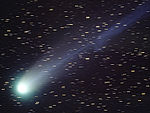266P/Christensen
Appearance
| Discovery | |
|---|---|
| Discovered by | Eric J. Christensen |
| Discovery date | October 27, 2006 |
| Designations | |
| 2006 U5 | |
| Orbital characteristics | |
| Epoch | 2020-04-21.0 |
| Aphelion | 4.736 AU |
| Perihelion | 2.335 AU |
| Semi-major axis | 3.535 AU |
| Eccentricity | 0.339 |
| Orbital period | 6.65 a |
| Inclination | 3.426° |
| Last perihelion | 2020-04-19[1][2] 2013-08-31 |
| Next perihelion | 2026-Dec-07 (JPL Horizons last obs 2020-04-16) |
266P/Christensen is a periodic comet in the Solar System. It will next come to perihelion in December 2026. It has been suggested as the source of the 1977 "Wow! Signal".[3]
References
[edit]- ^ "266P/Christensen Orbit". Minor Planet Center. Retrieved 2017-06-08.
- ^ Syuichi Nakano (2014-02-27). "266P/Christensen (NK 2619)". OAA Computing and Minor Planet Sections. Retrieved 2017-06-08.
- ^ Paris, Antonio (Winter 2015). "Hydrogen Clouds from Comets 266/P Christensen and P/2008 Y2 (Gibbs) are Candidates for the Source of the 1977 "WOW" Signal" (PDF). Washington Academy of Sciences. Retrieved 7 June 2017.
External links
[edit]- Orbital simulation from JPL (Java) / Horizons Ephemeris
- 266P on Seiichi Yoshida's comet list
- Elements and Ephemeris for 266P/Christensen[permanent dead link] – Minor Planet Center

